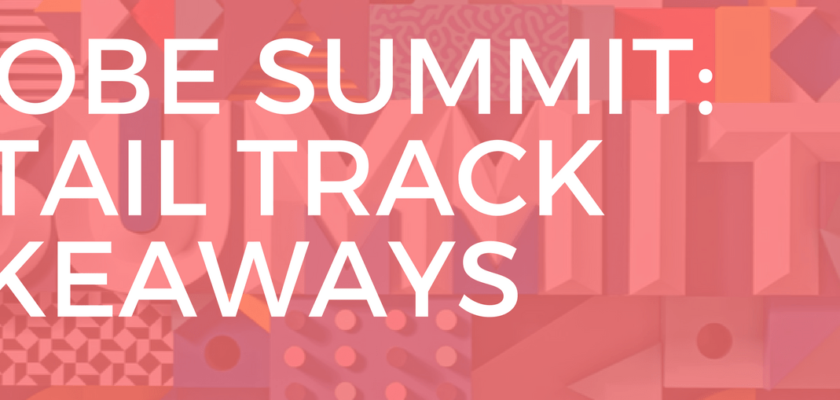Key Takeaways: How Retailers Execute with Empathy

We all know that retailers are now utilizing data and turning to technology to create great experiences, but there’s something about the combination of ‘data’ and collection’ that leaves a bad taste in customers’ mouths. We’re not here to denounce data and technology either, in fact, we preach it!
Don’t believe us? Then take it from Samsung, Westjet, and USAA, who taught us all that how we can use data to execute with empathy at this year’s Adobe Summit. We’ve broken down all of the wisdom we collected at the conference’s retail track into 3 easy steps to ensure that technology and consumer needs are well balanced.
Learn the best practices on omni-channel CRO and experimentation in our free guide.
Step 1: Understand the Customer
Jesse Laskaris lets us all in on the Samsung secret. They’ve become customer-centric by using data as a tool to fully understand their customers. Despite their millions of users, Samsung prides themselves on their dedication to customer segments and understanding each individual user. Data has been a key player in their personalization process and their road to a more customized consumer experience, something that all retailers have been attempting recently.
“Customers on mobile are different from customers that purchase washers and dryers – therefore the customer journeys need to be separated and personalized for each”
This basic understanding of their customer has given Samsung a great foundation for their omnichannel model and personalization strategy. Knowing who the customers are and what they want, have enabled them to make decisions that are backed by consumer behavior rather than wild guessing. Samsung applies their data-driven mindset as they strive to deliver the right content on the right channel, to the right customer. We don’t need to look too far away to realize the value it brings to every customer journey. Anytime a company sends you a promotional push notification, but sends your email obsessed friend a different promotion straight to their inbox, this personalization mentality is in action!
This understanding is especially important for retail companies because shopping doesn’t just happen in stores anymore. The typical customer journey spans from the web, mobile, out of the home advertising and the store. These added elements add significant variables to the mix and have made shoppers even more complex and unique than ever before. So it’s important for retailers to understand how all the data being collected create individual profiles, yet add to the bigger picture of what the modern consumer is looking for.
Step 2: Show that you Care
Now that you understand the customer, how do you show them that you care and are in this for them? WestJet shows that they care with endless A/B testing and experimentation.

WestJet’s Matt Ravlich explains that constant testing is the best way for the company to listen to the customers and get immediate feedback. Any retailer knows that you can’t speak on the behalf of the customer and that making your own assumptions won’t serve the customer at the end of the day. Like any relationship, communication is key. And when talking to every customer isn’t an option, you need to create those outlets for them. Experimentation gives you the remote opportunity to sit down and listen.
Matt also reminds us that one of the greatest ways to show that you care about your customers is to adopt a relentless drive to please the customer. At WestJet, that means finding creative ways around roadblocks and again, that’s where experimentation comes in. Instead of worrying about finding the perfect solution from the get-go, the experimentation culture that WestJet has implemented allows them to explore multiple solutions to see which delights users the most and solve their problems quickly.
So take it from WestJet: testing isn’t about optimizing the product, it’s about optimizing the overall customer experience. When there is an endless amount of replacements and substitutes, this is where retailers can differentiate themselves and build the loyalty and trust with a customer-driven mindset.
Feeling inspired and looking to start your own A/B testing strategy? Check out the Ultimate A/B Testing Guide!
Step 3: Time to Reflect
Before you can get better, you need to know where you stand first. Creating goals is only worthwhile when they make sense with your current abilities and where you want to progress. So don’t sell yourself short or force yourself to reach for the impossible when creating ambitious yet reasonable goals is all you need to grow.
This is why Luke Horgan and Matthew Schaub at USAA are obsessed with funnels and measuring everything. You’ll never know how you can improve if you don’t understand your own strengths and weaknesses yet.
“If you can’t measure it, you can’t improve it”
When Luke began to tell the story of how he met his wife at the bar, he promised it wasn’t just another nice story to tell. He used it to prove that any and all situations can be measured. The bar that night only presented a limited number of candidates and he was able to break down his process into a funnel of activity that eventually narrowed it down to just his wife. For retailers, the takeaway here is that you can measure everything from the number of quality prospects to the number of clicks you have on your website. Digital tools and channels are making it easier and easier to put a number on how you’re doing so that you no longer need to wonder if something is worthwhile. From there, you can create a clear game plan, which is the best way to communicate to customers that you are eager to grow and learn with them.
It’s not just about working hard but working smart to win over the competitive retail space. Blindly declaring goals and ignoring the importance of self (or company) reflection, stunts your own growth. Customers appreciate authenticity so the vision and goals of the company don’t align, that is one of the fastest ways to lose customers.
Easy as 1,2,3
The Adobe Summit truly solidified how technology and data can be our greatest asset as retailers navigate their way through the ever-changing landscape of retail. Samsung, WestJet, and USAA were great examples of companies that were able to harness the potential of technology to execute with empathy and remain customer-centric.
Jesse, Matt, Luke, and Matthew are all seasoned veterans in the retail space and the lessons they’ve shared brings the industry just that much closer to being able to serve the customers the way that they deserve. With these 3 easy steps, you can take your customers on a journey they will never forget!
- Understand the customer- Listening is key
- Show them you care by testing and experimenting
- Reflect and set appropriate goals by measuring every step of the way!

